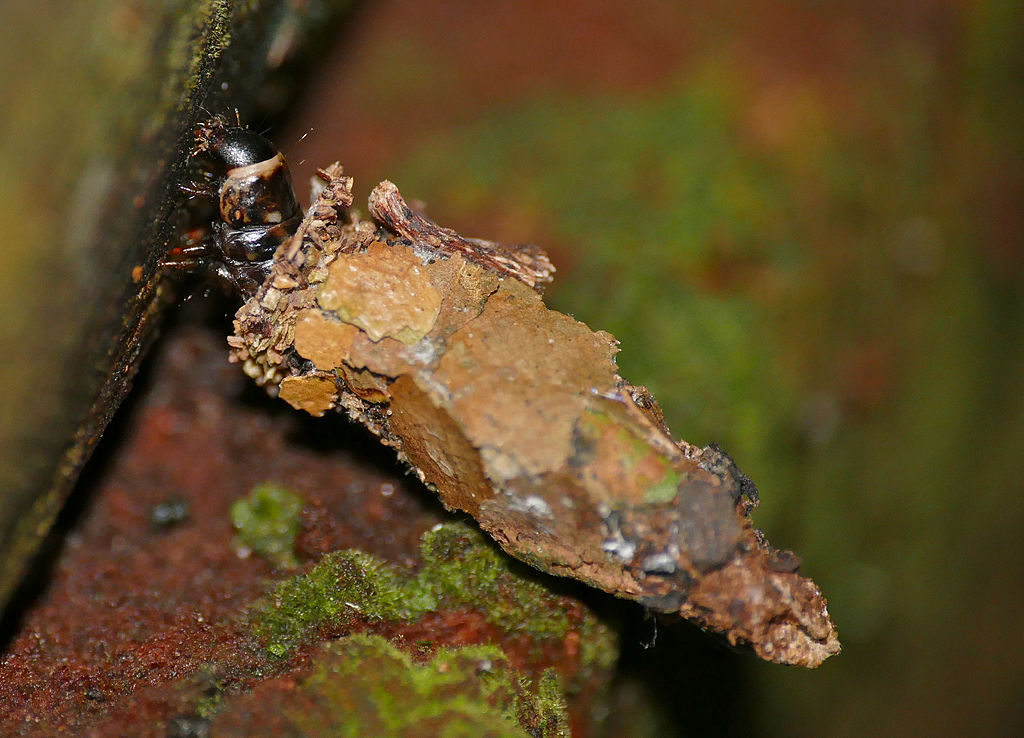Introduction
Bagworm (Thyridopteryx ephemeraeformis), also referred to as eastern bagworm, common bagworm, common basket worm, North American bagworm, or evergreen bagworm, is a native insect that infests many deciduous and evergreen tree species. The insect is named for the bag that it weaves during its larval stage. Bagworm is a voracious feeder, often defoliating the trees on which it resides. As such, it is considered a serious nuisance of host trees.
Distribution & Habitat
Bagworm is common throughout the eastern United States. The insect’s range also extends west to Kansas and Nebraska. It has occasionally been reported in South Dakota, and Texas. Bagworm is not often abundant in forested areas, but thrives in urban environments, where it has few natural predators.
Hosts
Bagworm infests a multitude of hosts. It prefers arbovitae and red cedar, but will also infest apple, birch, black locust, cypress, elm, honeylocust, Indian hawthorn, juniper, ligustrum, maple, oak, pine, poplar, spruce, sycamore, viburnum, and willow.
Description
Bagworm is most recognizable by the case or bag that the larvae establish. The bag is composed of silk, excrement, bark, and bits of foliage. The materials are interwoven to strengthen the bag. By the time the larvae are mature, the bags may reach one to two inches in diameter. The larvae are initially small, measuring around ¾ of an inch in length. The first three segments of the insect’s thorax is white to yellow, with a dark brown pattern. The posterior end of the thorax is medium to dark brown. As the larvae develop, the head and thorax establish a yellow tint. Once mature, the larvae measure 1 to 1 ¼ inches long. Adult males resemble moths. They have black furry bodies, and transparent wings, with a wingspan that extends up to an inch in diameter. Adult females appear similar to maggots. They have pale yellow bodies, and are bereft of eyes, legs, wings, or antennae. Small tufts of hair arise from either end of the abdomen. Females measure between ¾ of an inch and an inch long. The eggs are cream colored, and measure up to .03 inches in length. They are smooth and cylindrical in shape. The females lay their eggs in a waxy, tuft-like mass.
Life Cycle
Bagworm produces one generation per year. The eggs hatch from late May to early June, revealing masses of larvae. In the southern part of the insect’s range, the eggs may begin hatching in early April. If there is sufficient foliage, the larvae will remain on the host plant to feed. Other larvae descend from the bottom of the hanging bag, and weave a silken thread that they cling to. They linger on the silken threads, waiting to be disseminated by air currents to nearby plants. Dispersal over wide areas generally occurs due to heavy wind. The larvae may also be transported through the movement of infested nursery stock, and ornamental plants during early June.
Once the larvae have selected a host, they begin to feed on the plant’s foliage, constructing silken shelters, or bags, that conceal their bodies. The larvae reside within these bags, allowing their head and thorax to emerge from the anterior end as they feed. The larvae develop over eight to ten weeks, continuing to enlarge their bags with pieces of foliage, strips of bark, and excrement. Feeding persists until August, when the larvae mature. Once mature, the larvae attach their bags to a nearby branch, securing it with a silken thread. Once their bags are firmly attached, they seal any openings, and reverse their position so that they are facing downwards. In this state, they enter the pupal stage.
Adult males transform into moths within four weeks. From September to early October, they breach through the pupal skin, and vacate their bags. Upon emerging, the male adults seek out their female counterparts to mate. Adult females remain within their silken cocoons, emitting a strong pheremone that attracts the males. The males navigate to the females, and mate with them through an opening in the posterior end of the bag. Once they been fertilized, the females lay 500 to 1,000 eggs within their bags. They die shortly thereafter. Some females remain in their bags; others crawl out of their bags, and plummet to the ground, where they expire. The eggs overwinter in the bags, and begin to hatch the following spring.
Symptoms of Infestation
Bagworm larvae feed on the upper foliage of host plants, often gnawing small holes in the leaves, or needles. On evergreen trees, the larvae’s feeding causes the branch tips to turn brown. Severe infestations often result in significant defoliation. The insect’s persistent feeding reduces tree vigor, and may culminate in tree mortality. Deciduous trees that are healthy, but have been defoliated will usually produce a second flush of foliage by the end of the growing season. Once the larvae mature, and begin fastening their bags to nearby branches, the silk that the larvae use to secure the bags can produce a girdling effect. If the silk remains fixed to the branch for several years, the branch may die back. As the larvae prepare to pupate, the bags can be observed attached to the branches of host trees.
Management
- Bags from the previous year may be removed by hand in early spring, before the eggs begin to hatch.
- Bags may be pruned from infested plants during late fall, winter, or early spring. The bags become more conspicuous in fall once they have turned brown. Administer a pruning cut to the silken thread that holds them aloft, and safely dispose of the bags.
- Various insecticidal sprays can be utilized to control bagworm infestations. This method is ideal when bagworms become too numerous to control naturally. Applications should be performed in June, when the larvae are small. The larvae become more resistant to insecticidal sprays as they mature.
- Under certain weather conditions, entomopathogenic nematodes can help to reduce larvae populations.
- Bagworm has a plethora of natural predators that help to limit its populations. These predators comprise at least eleven species of parasitic wasps, including Pimpla disparis, Itoplectis conquisitor, and Gabrus ultimus. Other natural predators that commonly feed on the eggs and larvae include white-footed mice, and sparrows.
Photo courtesy of Bernard Dupont CC-by-SA 2.0.


